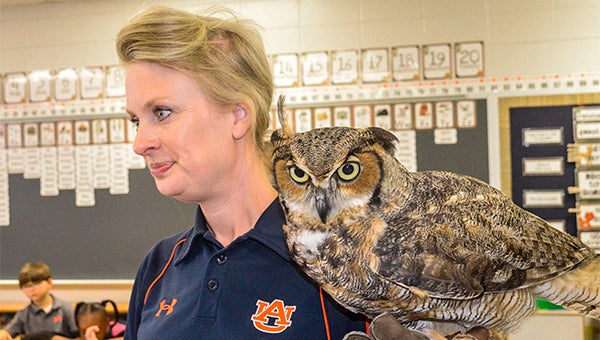Bird Lesson
Published 12:01 am Friday, April 8, 2016

Marianne Hudson, assistant director of the Southeastern Raptor Center at Auburn University, answered questions about raptors and then shared additional information about the birds of prey. At the close of the raptor program at TES Thursday, Madison Heinse found an owl feather on the floor. She will return the feather to the woods because owls are protected and it’s “against the law” to keep the their feathers.
Questions were strung out like lights on a Christmas tree.
“Why don’t owls have teeth?” “Can eagles kill everything?” “Can you catch a bird?”
Marianne Hudson, assistant director of the Southeastern Raptor Center at Auburn University, fielded the questions like Mickey Mantle roaming the outfield.
“Owls don’t have teeth because they don’t chew their food; they just swallow it,” Hudson said. “There are so animals that are faster their eagles so they don’t kill everything. Birds are fast. You can catch a bird but only if it’s hurt.”
Hudson was one of three Raptor Center staff members who presented programs about raptors or birds of prey at Troy Elementary School Thursday. All first grade students and a class of second graders were introduced to seven different raptors, including “Spirit” the Auburn University bald eagle mascot at a combined meeting in the school gymnasium.
Then, the students were treated to visits by the Raptor Center staff members and several of their feathered friends in the individual classrooms.
“By coming together in the gym, the students had the opportunity to see seven raptors,” said Heather Bunn, second grade teacher who coordinated the visit. “We wanted the students to get to see several of the raptors up close, so the staff members visited their classrooms and the students got to ask questions about raptors.”
Hudson had an answer for every question that was tossed her way.
She said birds of prey have larger eyeballs than people so they can see much better and even at night.
“About eight different kinds of owls are out hunting while you are asleep at night,” she told the young students. “Raptors do have sharp claws – as sharp as needles – so they can kill their food.”
Hudson told the students that raptors such as owls, hawks and eagles, don’t like to be touched.
“Everything that touches them, wants to eat them,” she said. “They don’t even like for me to touch them.”
The students were amazed that raptors can control every feather on their bodies.
“They can make one feather stick up and one feather lie down,” Hudson said. “What if you could control every hair on your head?”
Hudson and the other Raptor Center staff members presented a lot of interesting facts to the young students. And, they also told them about the Raptor Center and what it does to help protect birds of prey.
The Southeastern Raptor Center rehabilitates and releases hundreds of injured birds of prey each year. The Center releases about 30 percent of the 400 raptors that are treated annually at the center. There are 27 permanent “residents” at the center at this time.
“The permanent residents are the ones that are in such bad condition that they can’t be released into the wild,” Hudson said. “These non-releasable raptors are the ones we use for programs in schools.”
Hudson told the students that raptors are protected, meaning that it is illegal to capture or kill a raptor or to posses any part of one.
“If you find a feather from a raptor, you should not keep it. It should be returned to the woods,” Hudson said.
The first-graders at TES now have greater knowledge about and appreciation for all birds of prey thanks to a grant from the Troy Education Foundation and the program presented by the Raptor Center staff.


